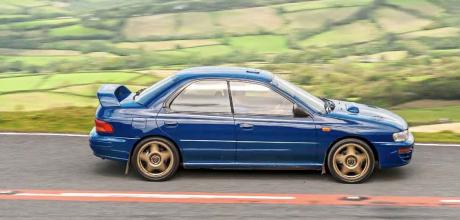1996 Subaru Impreza WRX STi
30 years ago, the world got its first glimpse of a new force in world rallying. Today, we hail one of the greatest classics of the Nineties with a flat-out drive in an early Subaru Impreza WRX STi through Welsh rally country.
Words SAM DAWSON
Photography LAURENS PARSONS
BUILT IN JAPAN, MADE IN BRITAINSubaru Impreza WRX STi
Impreza’s rally-bred superhero status celebrated in Wales.We take an exhilarating drive in Wales to mark 30 years of rallying Subaru Imprezas.
PLUS we reunite the Prodrive engineers who made it happen
There can be no word more overused in the classic car world than ‘Iconic’. PR people use it to describe nearly every old car, each one of its features, and every person connected with its early life. And yet today, as I attack yet another Brycheiniog hairpin, I find myself surrounded by sights and sounds that get me reaching again and again for the I-word.
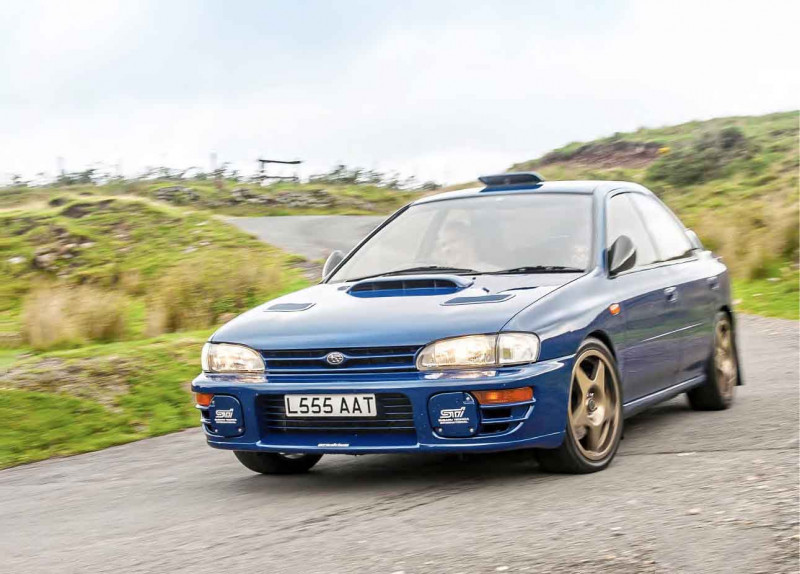
And all because I’m driving a Subaru Impreza WRX STi, on roads that once saw it clinch world championships, for British drivers in front of British crowds. Spectators for whom that very notion seemed like a pipedream for most of their lives.
Three decades ago, on that fateful, frozen November afternoon when I got my first glimpse of an Impreza in action, the response from most non-rally people would have been ‘a what?’ Unless you followed the British Rally Championship and saw the vast Legacy saloon spur upstarts Colin McRae and Richard Burns to domestic titles in the early Nineties, Subaru was a relatively unknown quantity in Britain.
The reason why the Legacy had picked up a cultish old-money image was at least in part down to the Japanese manufacturer’s dealerships. Rather than existing as a chain of showrooms in prominent positions, they were often found in out-of-the-way places and the 4x4-heavy range appealed primarily to country folk. The cars sometimes even shared space with agricultural plant. Hence why, when Barbour-jacketed gentleman farmers fancied a new car to go with their combine harvester, Subarus beckoned, with hard-wearing interiors and estate options making them perfect for muddy boots and beagles.
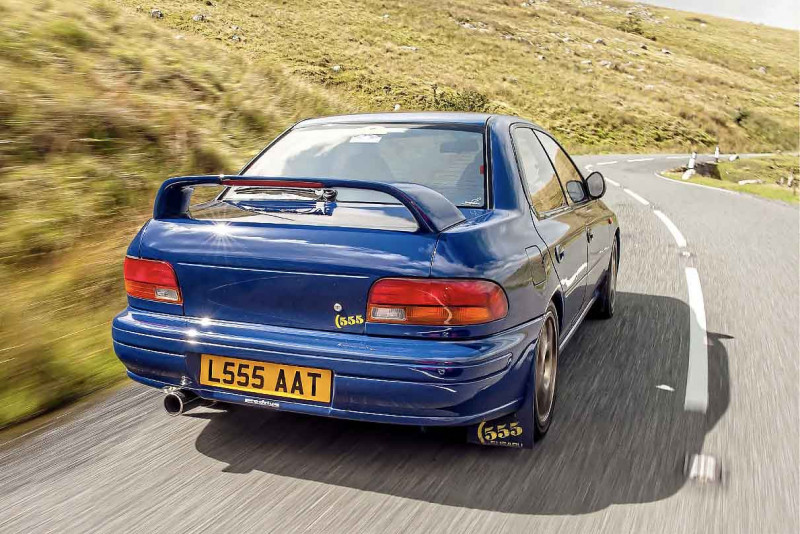
But back in 1993, when I stood by that Welsh forest road, Subaru presented the Impreza to the international stage. Although it had done one rally earlier in the year – the 1000 Lakes, with Ari Vatanen bringing one home in second – the RAC Rally saw the first meeting of Impreza and Colin McRae. The Scotsman had completed a partial campaign in 1993 with the Legacy, as Prodrive finally targeted the WRC in earnest. For we bobble-hatted BRC cultists it was the culmination of themes with long roots. International rallying had been dominated by Scandinavian and Mediterranean drivers and Italian, German and French teams for what seemed like forever.
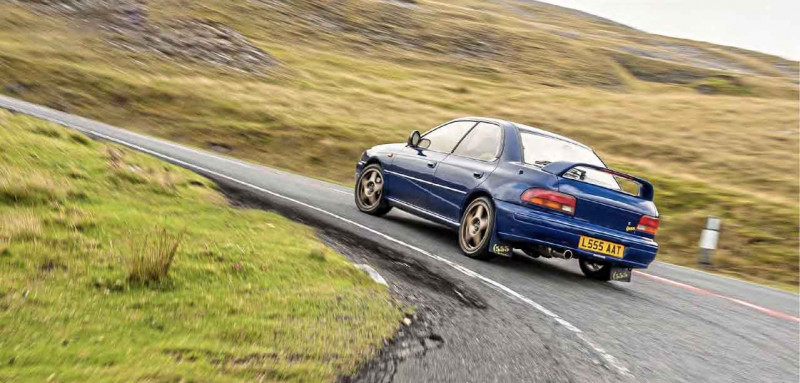
But something had been brewing in Banbury. David Richards’ Prodrive, formerly under the guise of Team Rothmans, had been mentoring young British driving talent as well as developing the Legacy into a title winner. In August 1993 in New Zealand, on the weekend of his 25th birthday, Colin McRae gave the Legacy RS an outright WRC win, something not even the great Vatanen managed that year. In November, this exciting young talent piloted a more competitive, compact, lighter, more dynamic Subaru. And by the time he flashed by my vantage point in that Welsh forest, the young Scot and his brand new Impreza were vying with quadruple-champion Juha Kankkunen’s Toyota Celica GT-Four for the lead before a rock holed his radiator. The BRC had produced generations of unfulfilled potential. Roger Clark, Russell Brookes, Louise Aitken-Walker, Malcolm Wilson, even McRae’s own father Jimmy – all had the class to win international rallies but never properly-funded works-backed machinery. Here was a home-grown talent who seemed to have the right car beneath him to finally win the WRC. Little did we realise that another British Prodrive graduate was waiting in the wings to perform the same feat six years later too.
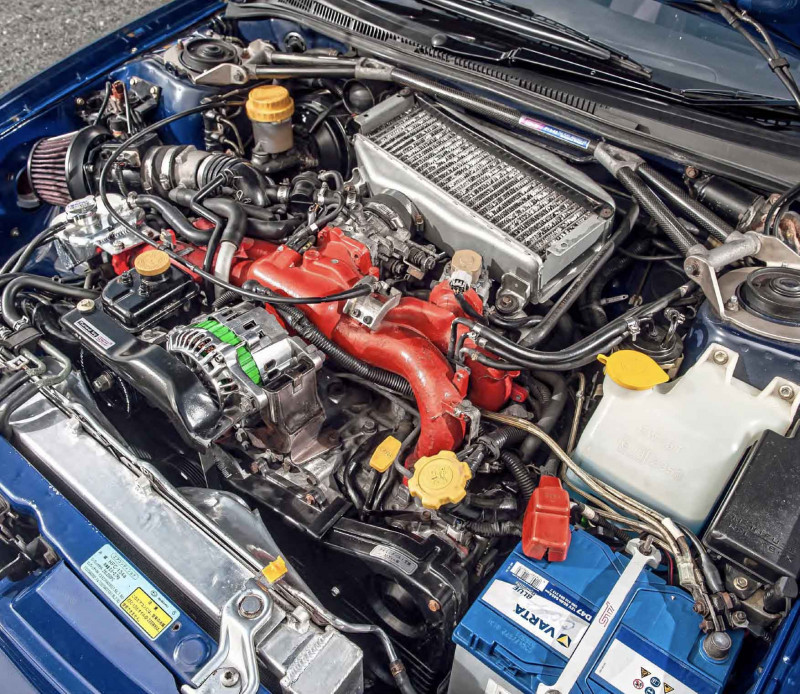
It’s odd, considering the excitement this Impreza still generates, to see how nondescript the early WRX STi is. It’s the definition of generic. Any number of badges could front its bland grille. The only visual interest is to be found in its aerodynamic additions – the front valance with its garish foglight covers, the huge rear wing. The mundanity continues inside too, with only a carbon-fibre instrument surround, a steering-column-mounted boost gauge and an elegant Nardi wheel fronting a sports seat differentiating it from, say, a Toyota Corolla.
And yet dull looks are accusations that could be levelled at a MkII Ford Escort, a car that won the World Rally Championship with Prodrive founder David Richards in the navigator’s seat, and which continues to dominate club rallying to this day. What it looks like isn’t important – it’s what it can do that counts. The Impreza’s driving position seems oddly perched at first. It’s very comfortable with its supportive bucket seats, but I’m sitting much higher up than I would be in a Ford Escort RS Cosworth, let alone a low-slung Toyota Celica GT-Four. However, it doesn’t take many Black Mountain bends to realise that this is an advantage. Coupled with thin pillars and mirror-tinted glarecutting glass that makes the rear windscreen look like a giant pair of Nineties Oakley sunglasses, you get an unimpeded view of twisty complexes of bends. Perfect for negotiating a special stage, I muse as I splash my way through a channel of yesterday’s rainwater running across a farm track, and line up a cattle grid.
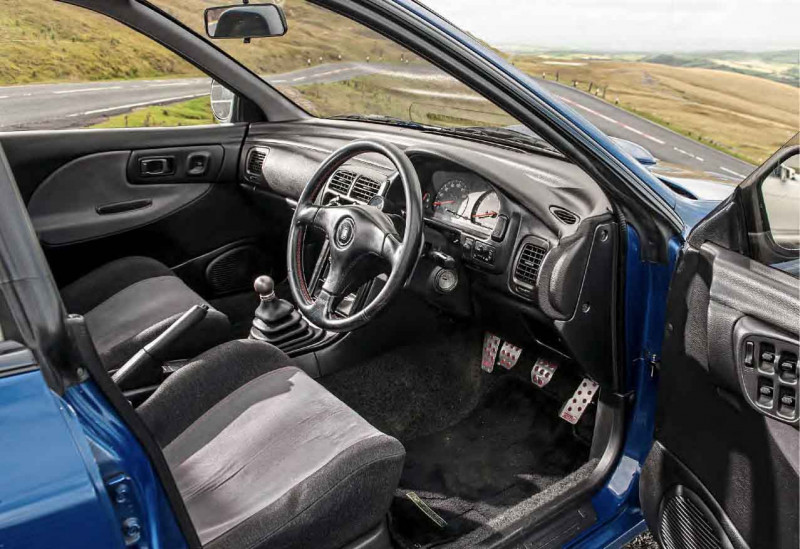
Confidence-building if you want to drive the Impreza hard. And it’s not long before I build the confidence to really press on. Interestingly, even as the revs rise higher, the unmistakable, charismatic flat-four throb that’s so dominant for bystanders is kicked into fourth place inside the car by a combination of shrieking gear whine, turbocharger hiss and wastegate flutter, and gravel ricocheting off the inside of the wheelarches. There’s no turbo lag of note, but rather an even stronger phase of thrust past 5000rpm, by which point in most of the gears in its slightly vague-actioned ’box I’m already going faster than I’d normally dare. It’s a good thing there are only sheep watching today.

But back in the Nineties, the Impreza had an audience of millions on TV and stageside alike. As McRae and, later, Richard Burns, racked up international wins and World Championships, more and more British rally fans experienced the thrill of driving them. And not just on screen either – my first turn behind the Impreza’s wheel was on the 1996 MS-DOS classic Network Q RAC Rally Championship, one of the few video games to bother properly replicating all the special stages. But for rally fans a few years older than me with driving licences and jobs, the Impreza was something they could seriously consider buying.
In 1993, the Impreza 2000 Turbo – as the earliest iteration of the boosted 4x4 Group A homologation special was called – cost just £17,499. Golf GTi money. The Impreza’s on-stage Group A four-wheel drive turbo rivals started with the outgoing £23,395, left-hand drive, special-import-only Lancia Delta Integrale, then the near-uninsurable £24,810 Ford Escort RS Cosworth, and the £24,999 Toyota Celica GT-Four. That was money that would buy you a Porsche 968 Club Sport or a TVR Chimaera or, if you fancied something plush for the same price, a BMW 7 Series.

And yet, the Impreza was faster than all of them. Here was a car costing hot hatch money that did the 0-60mph sprint in 5.7 seconds. In 1993, the Escort Cosworth was considered necksnapping with its 6.2-second time. By contrast, a car that cost so much less than the Cossie that it would leave you with enough change to buy a new Fiesta offered the same acceleration from rest as a Ferrari 348tb. And it wasn’t even in the highest insurance bracket either, a serious consideration given how rife car crime was back in the early Nineties. While the Escort contended with Group 20 – the same as a 348 – the Impreza sat in Group 17 with the Volvo 960 estate.
Then bear in mind the economic feelgood-factor that was just around the corner. In 1992-3 the UK was in the depths of the recession but from 1994-2008 the UK experienced an unbroken period of economic growth, based largely on GDP rather than asset-price inflation, which was experienced across the board. During this time, Subaru racked up three WRC Manufacturer’s titles and made World Champions of Colin McRae, Richard Burns and Petter Solberg. Its main opposition came from Mitsubishi, but the Lancer Evo was an expensive and aloof special-order grey-import from Japan. By contrast, buying an Impreza was easy. You could even get it as an estate.
How was Subaru able to offer such incredible performance at such a low price? The answer is visualised as I crest the hills above Swansea and look down upon acres of farmland no doubt at least partly tended to by Subaru Foresters and BRAT pick-ups. While the likes of Ford created their 4wd systems at great cost to fit in bespoke performance versions of the Sierra and Escort, Subaru merely reached into its parts bin. The flat-four engine and symmetrical 4wd system had been mass-produced Subaru mainstays since 1972. To Subaru, the Impreza Turbo was no more difficult to make than an Outback. It left the fine-tuning that gave it the edge to Prodrive, under the guise of Subaru Technica International (STi).
David Richards hails from the forests of Clwyd, three hours’ drive north of here, and was introduced to motor sport via local rallies, honing his craft on snaking forest roads. Prodrive’s work on the Impreza renders it an object lesson in the difference between handling and roadholding. Although the steering feels relatively numb through the Nardi wheel, with none of the granular feedback you get in an Integrale, its handling is remarkably precise. There’s none of the understeer you get from the nose-heavy Audi S2 Quattro – at £30,495, the Subaru’s most expensive direct rival. You just point the nose and it follows the wheel’s line without so much as a tug or squeal of protest.
The grip is immense too. I aim the Impreza at a gravelly set of S-bends ending in a near-square right-hander before a narrow, low-set bridge, and despite the challenge of loose stones, there’s barely a hint of wheelspin as the combined grip compensates for any loss of traction. I find a layby, turn around and tackle the bend again, faster this time, and yet still it doesn’t slide. However, nor does it communicate any progressive loss of roadholding. I get the impression that I could keep pushing this car harder and harder, with no sign of anything untoward until the tyres finally reached the limits of their adhesion, the downforce measures had nothing to counter it and the Subaru simply slipped off the road and rolled.
Burns and Solberg knew where its limits were. McRae would happily push straight past them. But for me and most Impreza drivers, we’re just grateful that something so crushingly competent, offering a set of characteristics historically associated with astronomically expensive supercars, was and is available so affordably.
As I pull the Impreza up in a mountaintop car park, it’s this factor that brings me back yet again to that word, iconic. Use it meaningfully and the car has an immense amount to live up to. Motor sport-wise it means man-and-machine pairings like Jim Clark and Lotus or Derek Bell and Porsche. Engineering-wise it means living up to the kind of innovative and effective legacy left by someone like Giampaolo Dallara or Amédée Gordini. In terms of visual imagery, it needs to be up there with a Gulf Ford GT40. Culturally it means the reputation of someone like James Hunt and the kind of action worthy of cinema. Can this nondescript Japanese saloon genuinely live up to that?
Of course it can. McRae and Burns breaking the Scandinavian stranglehold on world rallying. Prodrive demonstrating mastery across all forms of motor sport engineering. A livery so synonymous with the car that the average trackside punter thought 555 was the name of the rally team rather than a brand of cigarettes rarely seen in British shops. Down-to-the-wire battles throughout the mid-Nineties that saw World Rally Championships won or lost by single-figure point margins. And all led by a car that a lot of people could go out and buy with an ease unseen since the days of rear-drive Escorts, or drive in pixelated form on their computer. To my generation, there is no greater icon of the Nineties than the Subaru Impreza.
TECHNICAL DATA 1996 Subaru Impreza WRX STi
- Engine 1994cc horizontally-opposed four-cylinder, dohc per bank, Denso 400 electronic fuel injection, IHI VF34 turbocharger
- Max Power 280bhp @ 6500rpm
- Max Torque 253lb ft @ 4000rpm
- Transmission Five-speed manual, four-wheel drive
- Steering Rack and pinion, power-assisted
- Suspension Front: independent, MacPherson struts, coil springs, telescopic dampers, anti-roll bar. Rear: parallel transverse arms, trailing arms, coil springs, telescopic dampers, anti-roll bar
- Brakes Servo-assisted discs front and rear
- Weight 1250kg
- Performance Top speed: 137mph
- Acceleration 0-60mph: 5.7sec
- Cost new £17,499
- Classic Cars Price Guide £5750-£10,500
The Impreza truly made its name in Wales. Immense grip, limited feedback. Numberplate one digit away from McRae’s 1995 winner. Roof vent was a 555 Edition Group A option. Prodrive’s WRC work informed options list. Most distinctive exhaust note of the Nineties? Bonnet scoop feeds skewed intercooler. 555 made blue-and-gold scheme iconic Nardi wheel and aluminium parts give rally feel.
‘Prodrive’s work on the Impreza renders it a lesson in the difference between handling and roadholding’
OWNING A SUBARU IMPREZA WRX STI
‘For me, and many other Impreza owners I imagine, it’s an obsession that began with Colin McRae in the Nineties,’ says this car’s owner Dale Webb. ‘I was driving a Ford Escort RS Turbo at the time, but it wasn’t long before I bought my first Impreza, initially a normally-aspirated base model – very rare now – then moved on to a Turbo. I had 11 at one point and even today my daily driver is an XV – I’ve had nothing but Subarus since.
‘There was a long period where they were very cheap, but that’s ended abruptly now. During that time, they were actually worth more broken for spares – which is why you never see the base models any more – and as a result nowadays prices are shooting up again. You’ll be lucky to find a really good one for less than £10k, although they’re very reliable so a scruffy high-miler can potentially be a bargain.
‘Parts supply is a major issue though. Subaru’s dealer network is minimal and they no longer make spares for them, so everything involves breakers, increasingly in the US and Australia. The cars are often painted the wrong colour too – Subaru chose Monaco Blue, the closest in its range to 555’s cigarette packets, for the 555 Edition. But it wasn’t quite purple enough for 555, so the rally cars were repainted in a shade sourced from Renault – not that Subaru could ever admit it.’


